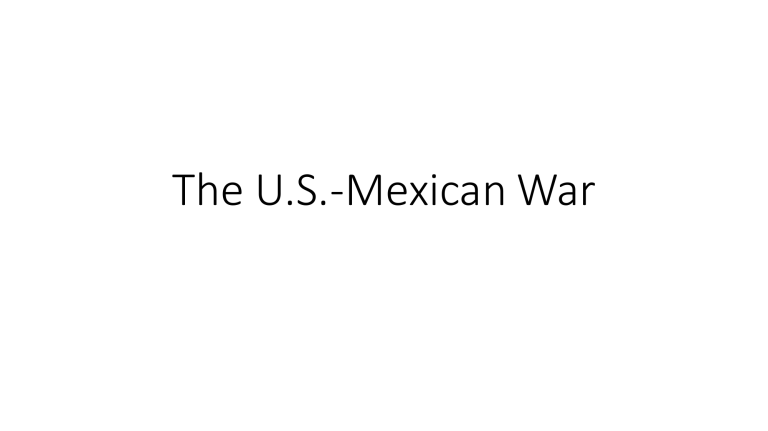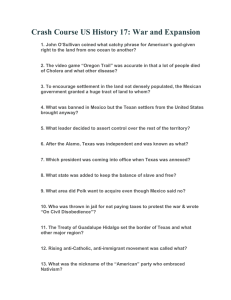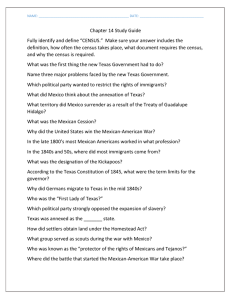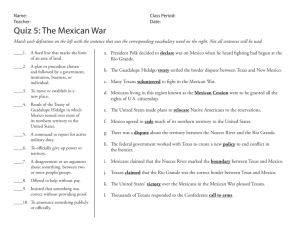
The U.S.-Mexican War Fighting Breaks Out • Many Mexicans were unhappy about the annexation of Texas. • They feared that annexation was just the first step and that the United States wanted to take over all of Mexico. • The conflict between Mexico and the United States was not new. • Mexico had claimed that the Nueces River was the boundary • The United States believed the Rio Grande was the boundary. Fighting Breaks Out • In November 1845 President James K. Polk sent John Slidell to Mexico to settle the disputes. • Slidell was authorized to purchase New Mexico and California. • Mexican officials refused to meet with him. • Polk ordered General Zachary Taylor and thousands of soldiers to Texas. • mission was to protect the new state from any attack. • When Taylor’s troops arrived along the Rio Grande in March 1846, they discovered Mexican troops camped across the river. • Taylor ordered his men to build a fort near what is now Brownsville. Fighting Breaks Out • In early April, a Mexican general sent a message to Taylor, ordering him to return to the east bank of the Nueces. • Taylor refused. • In response, Mexican cavalry crossed the Rio Grande and attacked. • Several U.S. soldiers were killed or wounded, and many more were taken captive. Fighting Breaks Out • When Polk heard this news, he asked Congress to declare war. • the Mexican American War was declared on May 13, 1846. • On May 8 and 9, U.S. troops fought General Mariano Arista’s advancing forces at Palo Alto and Resaca de la Palma near Fort Brown. • Taylor won both battles. What role did the Rio Grande play in the outbreak of the Mexican American War? The United States argued that the Rio Grande was the border, while Mexico disagreed. U.S. and Mexican troops staged along the Rio Grande soon engaged in conflict. Texans in the War • Thousands of volunteers rushed to join the army when the call for war came. • In Texas, many people welcomed a chance to fight against their old rival Santa Anna. • They wanted to get revenge for the suffering Texans had experienced during the Revolution. Texans in The War • Some 6,000 Texans volunteered to fight in the U.S.–Mexican War. • Even Governor James Pinckney Henderson temporarily left office to serve in the army. • Former president of Texas Mirabeau B. Lamar and Texas revolutionary Albert Sidney Johnston also volunteered. Texans in the War • Several of the Texas Rangers who joined the U.S. forces during the war served as scouts. • The Rangers’ fame as fighters spread quickly. • Several Rangers, including John S. “Rip” Ford, Jack Coffee Hays, and Ben McCulloch, were recognized for their leadership and bravery. • Some Rangers’ actions caused problems • At times they refused to follow the orders of U.S. Army officers. • Rangers occasionally attacked Mexican villages with little reason • General Taylor threatened to throw all the Rangers in jail. • Many Mexicans feared the Rangers, calling them los diablos Tejanos—“ the Texas devils.” A U.S. Victory • After winning a few battles in Texas, Taylor began an offensive —a major troop advance into northern Mexico. • He defeated a Mexican army at Monterrey and pushed farther into Mexico. • In 1847 Taylor’s troops met a larger Mexican army at Buena Vista. A U.S. Victory • After two days of fighting, Santa Anna’s forces retreated. • Because of his success at Buena Vista, Taylor became a national hero. • President Polk was not happy about the general’s new popularity, and he decided to replace Taylor as commander of the army. • Winfield Scott. • Scott chose to pursue a different strategy than Taylor had. • He sailed to Veracruz, which had the strongest fortress in Mexico. • After a long artillery battle, Scott took control of the city. • He then moved inland. A U.S. Victory • Santa Anna tried desperately to stop the U.S. advance, but he failed. • By August 1847, Scott had reached Mexico City. • Scott ordered a massive attack on the city. • Fighting took place in the streets and even on the rooftops. • Finally, on September 14, 1847, Mexico City fell. A U.S. Victory • U.S. troops raised the American flag over the National Palace in victory. • Of the approximately 116,000 U.S. soldiers who served in the war, nearly 13,000 lost their lives. • Most of these soldiers died not in battle but from disease. • More than 60 Texans died in battle, and more than 270 more died from disease or accidents. • The war with Mexico had cost the United States nearly $98 million. • In Mexico, countless lives were lost, and much property was destroyed. The Treaty of Guadalupe Hidalgo • After the capture of Mexico City, Mexican officials met with U.S. diplomats to discuss peace terms. • Their meeting took place near Mexico City at the town of Guadalupe Hidalgo. • On February 2, 1848, diplomats from the two countries signed the Treaty of Guadalupe Hidalgo, officially ending the Mexican War. The Treaty of Guadalupe Hidalgo • The treaty favored the United States. • Mexico officially recognized Texas as part of the United States. • Mexico gave up all claim to the territory between the Nueces and the Rio Grande. • Mexico also agreed to give 529,000 square miles of additional territory, including California, to the United States for $15 million. • Mexicans living in this region, known as the Mexican Cession, were to be granted all the rights of U.S. citizenship. • In return, the United States agreed to cover the $3.25 million in claims that U.S. citizens had against Mexico. The Treaty of Guadalupe Hidalgo • The addition of so much territory to the United States reignited old debates about slavery. • As before, the debate was split over regional lines. • Legislators from pro-slavery states wanted to allow slavery in the new territories, while antislavery legislators wanted to ban it. The Treaty of Guadalupe Hidalgo • The Mexican Cession also raised questions about the borders of Texas. • Texans claimed that the state Included all land east of the Rio Grande. • Included nearly half of present-day New Mexico, including the trading city of Santa Fe. • Early in 1848, the Texas legislature declared the huge disputed region to be Santa Fe County, Texas. The Treaty of Guadalupe Hidalgo • However, the people in this region—particularly in Santa Fe— rejected the Texas claim. • Most people in Santa Fe opposed slavery and had no desire to become part of a slave state like Texas. • Pro-slavery Southern members of the U.S. Congress supported the Texas claim. • Northern members argued against it. The Treaty of Guadalupe Hidalgo • In 1850 Senator Henry Clay of Kentucky came up with a plan to resolve both the border conflict and the issue of slavery in the Texas and New Mexico. • His plan was called the Compromise of 1850. • the federal government payed Texas $10 million to give up its claim. • The Texas state government needed money to pay debts • Texas voters approved the agreement. • The plan also established the present-day border between Texas and New Mexico. • In addition, New Mexico and Utah became territories, and California became a state. Tejanos and the War • Perhaps the greatest impact of the U.S.– Mexican War was felt by Tejanos. • Since the Texas Revolution, many Tejanos had been treated with suspicion and distrust by other Texans. • Many questioned their loyalty. • As conflicts emerged with Mexico during the 1840s, discrimination against Tejanos increased. Tejanos and the War • During the U.S.–Mexican War, many Texans viewed Tejanos as enemies because of their Mexican and Spanish ancestry. • Some Tejanos, fearing that they would lose their farms and ranches because of the war, sold their property—often at low prices—and left Texas. • Others were forced to leave Texas under threats of violence and had their land taken without payment. • Many of those who left lived in areas that had only recently become part of Texas. • Therefore they did not consider themselves Tejano at all. • Most of them headed south to Mexico. Tejanos and the War • The Treaty of Guadalupe Hidalgo guaranteed that Mexican Americans would receive equal protection under U.S. law. • Nonetheless, discrimination against Tejanos continued. • Tejanos in some cities, such as Austin, Seguin, and Uvalde, were driven from their homes during the 1850s. • Despite discrimination, many Tejanos remained in Texas. • Those who lived south of the Nueces—the new Tejanos—made up a large percentage of the South Texas population. • However, few of the area’s political leaders were from Tejano communities. New Migration to Texas • After the Mexican War, the population of Texas grew rapidly. • From 212,592 people in 1850, the population swelled to 604,215 by 1860. • Most new Texans were farmers from the southern United States. • Many of them brought slaves when they came. • As a result, the African American population in Texas nearly tripled between 1850 and 1860. • However, fewer than 800 free African Americans lived in Texas during this time. • The Texas population also included more than 12,000 Tejanos, mostly in the southern region of the state. New Migration To Texas • Many Europeans also came to Texas during this time. • Most wanted to escape hardships in their homelands. • Crop failures had left people starving in Ireland and parts of central and northern Europe. • In addition, a series of revolutions in 1848 led many people to leave. • Germans made up the largest European immigrant group, with a population of more than 20,000 in 1860. New Migration To Texas • The mid-1800s saw immigrants from all parts of Europe arriving in Texas. • French, Polish, Slavic, Jewish, Norwegi an, Italian and Belgian • Their settlements helped push the frontier westward. • Each group brought its traditional foods, celebrations, and architecture to Texas. • The influence of these various cultural traditions spread across the state.





